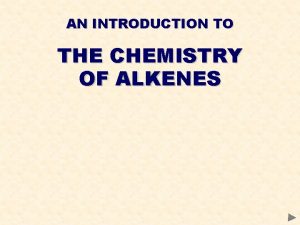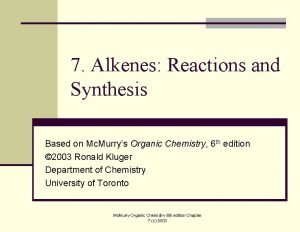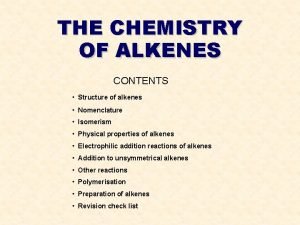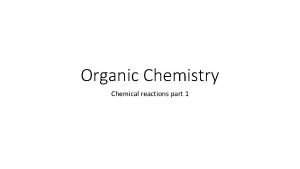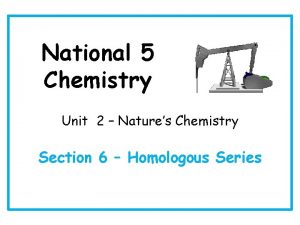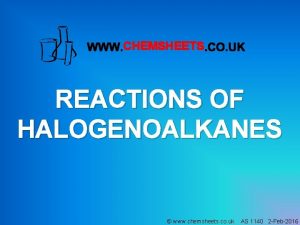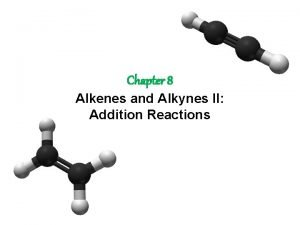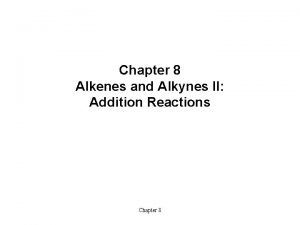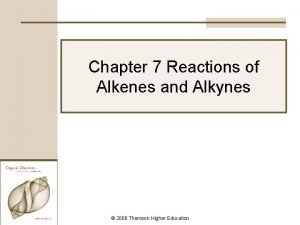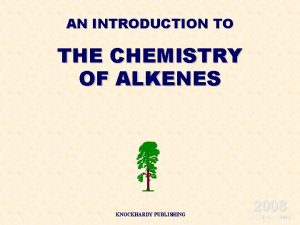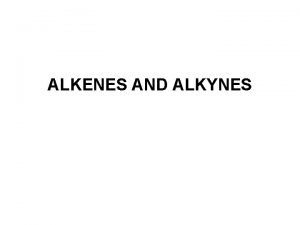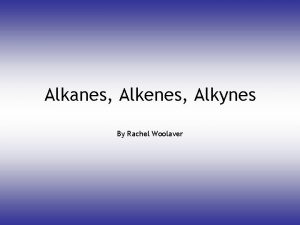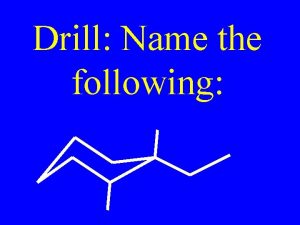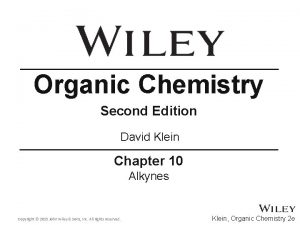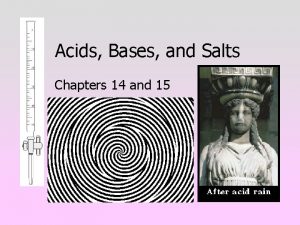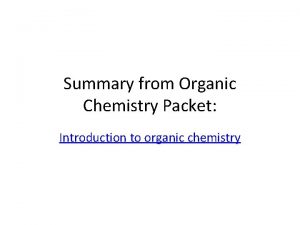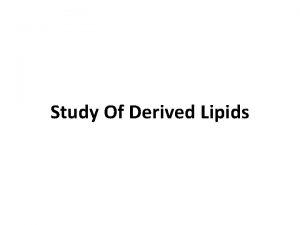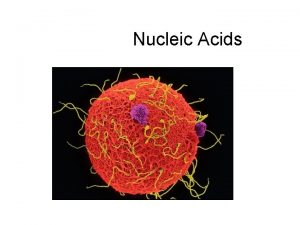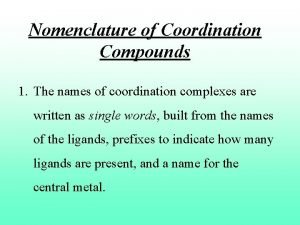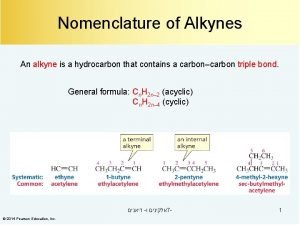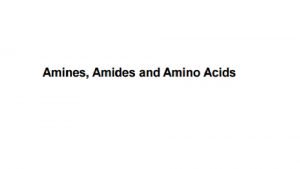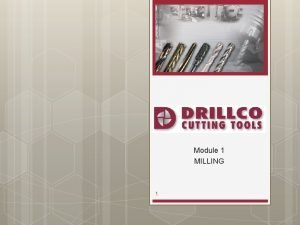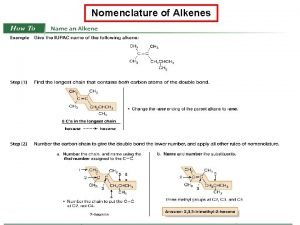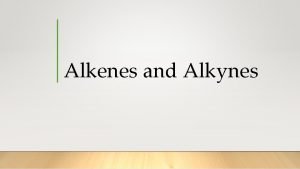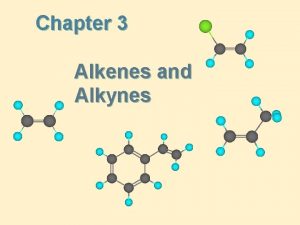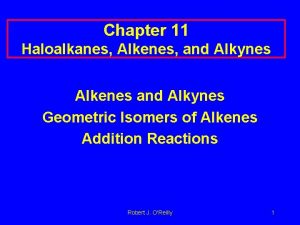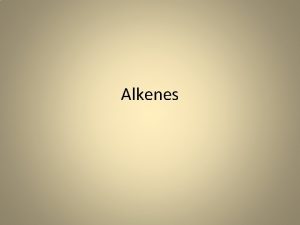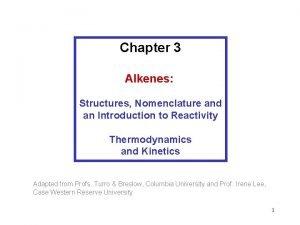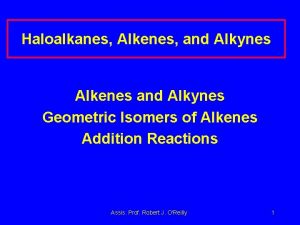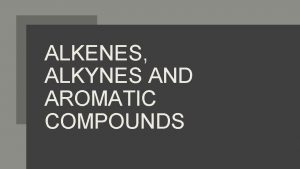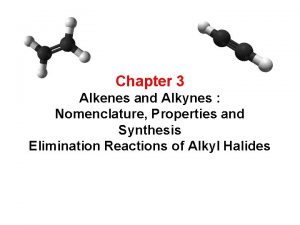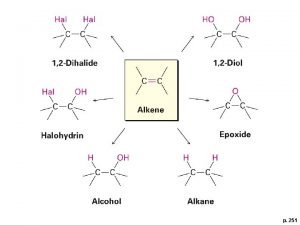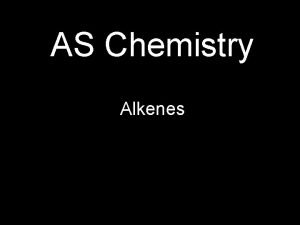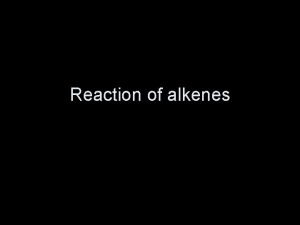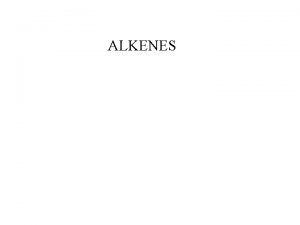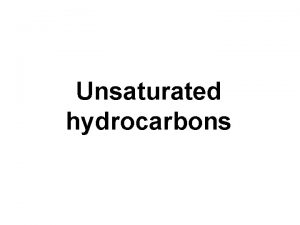Chapter 5 Alkenes Structure Nomenclature and an introduction




































- Slides: 36

Chapter 5 Alkenes Structure, Nomenclature, and an introduction to Reactivity • Thermodynamics and Kinetics Paula Yurkanis Bruice University of California, Santa Barbara

Contents of Chapter 5 n General Formulae and Nomenclature of Alkenes Reactivity Considerations n Curved Arrow Mechanisms n Thermodynamics and Kinetics n Chapter 4 2

General Molecular Formula for Alkenes n General molecular formula for acyclic alkanes is Cn. H 2 n+2 CH 3 CH 2 CH 2 CH 3 an alkane C 5 H 12 Cn. H 2 n+2 Chapter 4 3

General Molecular Formula for Alkenes n Each bond introduced, reduces the H content by 2 CH 3 CH 2 CH=CH 2 an alkene C 5 H 10 Cn. H 2 n Chapter 4 4

General Molecular Formula for Alkenes n Each ring also reduces the H content by 2 a cyclic alkane C 5 H 10 Cn. H 2 n Chapter 4 5

General Molecular Formula for Alkenes n n Generalization: The molecular formula for a hydrocarbon is Cn. H 2 n+2 minus 2 hydrogens for every bond and/or ring present in the molecule Each bond or ring is considered a unit of unsaturation. C 5 H 8 Cn. H 2 n-2 a cyclic alkene with 2 units of unsaturation Chapter 4 6

Saturated and Unsaturated Hydrocarbons n Alkanes or saturated hydrocarbons contain the maximum number of carbon -hydrogen bonds CH 3 CH 2 CH 2 CH 3 a saturated hydrocarbon Chapter 4 7

Saturated and Unsaturated Hydrocarbons n Alkenes contain fewer than the maximum number of carbon-hydrogen bonds and are therefore referred to as unsaturated hydrocarbons CH 3 CH 2 CH=CH 2 an unsaturated hydrocarbon Chapter 4 8

Nomenclature of Alkenes IUPAC names of alkenes are based on the corresponding alkane with “ane” replaced by “ene” Chapter 4 9

IUPAC Rules for Alkene Nomenclature 1. The longest chain containing the functional group (the double bond) is numbered such that the double bond is the lowest possible number Chapter 4 10

IUPAC Rules for Alkene Nomenclature 2. If there are substituents, the chain is still numbered in a direction that gives the double bond the lowest number Chapter 4 11

IUPAC Rules for Alkene Nomenclature 3. If chain has more than one substituent, they are cited in alphabetical (not numerical) order. Rules for alphabetizing are the same as for alkanes Chapter 4 12

IUPAC Rules for Alkene Nomenclature 4. If the same number for the double bond is obtained in both directions, number in the direction that gives lowest number to a substituent. Chapter 4 13

IUPAC Rules for Alkene Nomenclature 5. In cyclic compounds, a number is not needed to denote the position of the functional group The double bond is assumed to be between carbons 1 and 2 Chapter 4 14

IUPAC Rules for Alkene Nomenclature 6. If both directions yield same low number for a functional group and for one substituent, number in the direction which yields the lower number for one of the remaining substituents Chapter 4 15

IUPAC Rules for Alkene Nomenclature n Two groups containing double bonds that are used as names for substituents are the vinyl group and the allyl group Chapter 4 16

IUPAC Rules for Alkene Nomenclature The sp 2 carbons of an alkene are called vinylic An sp 3 adjacent carbon is called allylic Chapter 4 17

IUPAC Nomenclature of Dienes • Find the longest chain containing both double bonds 1 2 3 4 5 3 -butyl-1, 4 -pentadiene Chapter 4 18

IUPAC Nomenclature of Dienes • Use corresponding alkane name but replace the “ne” ending with “diene” 3 -butyl-1, 4 -pentadiene “pentane” changed to “pentadiene” Chapter 4 19

IUPAC Nomenclature of Dienes • Number in the direction that gives the lowest number to a double bond 1, 5 -heptadiene not 2, 6 -heptadiene Chapter 4 20

IUPAC Nomenclature of Dienes • List substituents in alphabetical order 5 -ethyl-2 -methyl-2, 4 -heptadiene Chapter 4 21

IUPAC Nomenclature of Dienes • Place numbers indicating the double bond positions either in front of the parent compound or in the middle of the name immediately before the diene suffix 5 -ethyl-2 -methyl-2, 4 -heptadiene or 5 -ethyl-2 -methyl-hepta-2, 4 -diene Chapter 4 22

The E, Z System of Nomenclature Left: Z-1 -bromo-2 -chloropropene Right: E-1 -bromo-2 -chloropropene Chapter 4 23

Relative Stabilities of Alkenes Chapter 4 24

Relative Stabilities of Alkenes n n n The more alkyl substituents attached to a double bond the more stable the double bond. Trans alkenes more stable than cis alkenes Not difficult concepts but should be learned now in order to understand Chapter 9 later. Chapter 4 25

Reactivity Considerations n n n Electrophiles react with nucleophiles An alkene has electron density above and below the bond making it electron -rich and therefore a nucleophile Therefore alkenes react with electrophiles Chapter 4 26

Reaction Mechanisms n We use curved arrows to indicate the movement of pairs of electrons as two molecules, ions or atoms interact Chapter 4 27

Reaction Mechanisms n Curved arrows are drawn only from the electron-rich site to the electron deficient site Chapter 4 28

Thermodynamics n When G° is negative the reaction is exergonic Chapter 4 29

Thermodynamics n When G° is positive the reaction is endergonic Chapter 4 30

Kinetics n n n Knowing the G° of a reaction will not tell us how fast it will occur or if it will occur at all We need to know the rate of reaction The rate of a reaction is related to the height of the energy barrier for the reaction, G‡, the free energy of activation Chapter 4 31

Free Energy of Activation Chapter 4 32

Rate-Determining Step n n Formation of the carbocation intermediate is the slower of the two steps It is the rate-determining step Chapter 4 33

Rate-Determining Step n n Carbocation intermediates are consumed by bromide ions as fast as they are formed The rate of the overall reaction is determined by the slow first step Chapter 4 34

Transition States and Intermediates n n It is important to distinguish between a transition state and a reaction intermediate A transition state n n n is a local maximum in the reaction coordinate diagram has partially formed and partially broken bonds has only fleeting existence Chapter 4 35

Transition States and Intermediates n An intermediate n n is at a local minimum energy in the reaction coordinate diagram may be isolated in some cases Chapter 4 36
 Alkenes introduction
Alkenes introduction Diol formation from alkene
Diol formation from alkene Bromine test for unsaturation
Bromine test for unsaturation Complete combustion of alkenes
Complete combustion of alkenes Explain homologous series with example
Explain homologous series with example Chemsheets as 1128 answers
Chemsheets as 1128 answers Ozonolysis of alkyne
Ozonolysis of alkyne Addition of halogens to alkenes
Addition of halogens to alkenes Hobr addition to alkene
Hobr addition to alkene Properties of alkenes
Properties of alkenes General formula of alkene
General formula of alkene Alkanes alkenes alkynes
Alkanes alkenes alkynes Hybridization of alkenes
Hybridization of alkenes Name the following alkenes
Name the following alkenes Alkyne prefix
Alkyne prefix Bromine water test
Bromine water test Nonene
Nonene Alkyne halogenation
Alkyne halogenation Essay structure
Essay structure 7 strong acid
7 strong acid Example of criminal law
Example of criminal law Nomenclature of bolts
Nomenclature of bolts Ta 202
Ta 202 Basic organic nomenclature packet
Basic organic nomenclature packet Pufas examples
Pufas examples Spring nomenclature
Spring nomenclature Skl kov-21 error
Skl kov-21 error E rigging supply
E rigging supply Shotgun nomenclature
Shotgun nomenclature Oxo functional group
Oxo functional group Nucleotide nomenclature
Nucleotide nomenclature Pentose sugar structure in dna
Pentose sugar structure in dna Coordination compound nomenclature
Coordination compound nomenclature Lindlar pd
Lindlar pd Ester nomenclature
Ester nomenclature Amine functional group
Amine functional group End mill nomenclature
End mill nomenclature
